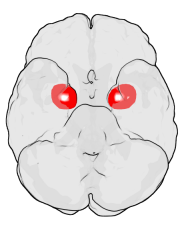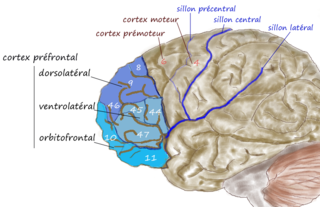Related Research Articles

Dissociative fugue, formerly called a fugue state or psychogenic fugue, is a rare psychiatric phenomenon characterized by reversible amnesia for one's identity in conjunction with unexpected wandering or travel. This is sometimes accompanied by the establishment of a new identity and the inability to recall personal information prior to the presentation of symptoms. Dissociative fugue is a mental and behavioral disorder that is classified variously as a dissociative disorder, a conversion disorder, and a somatic symptom disorder. It is a facet of dissociative amnesia, according to the fifth edition of the Diagnostic and Statistical Manual of Mental Disorders (DSM-5).

A sleep disorder, or somnipathy, is a medical disorder of an individual's sleep patterns. Some sleep disorders are severe enough to interfere with normal physical, mental, social and emotional functioning. Sleep disorders are frequent and can have serious consequences on patients' health and quality of life. Polysomnography and actigraphy are tests commonly ordered for diagnosing sleep disorders.

The amygdala is a paired nuclear complex present in the cerebral hemispheres of vertebrates. It is considered part of the limbic system. In primates, it is located medially within the temporal lobes. It consists of many nuclei, each made up of further subnuclei. The subdivision most commonly made is into the basolateral, central, cortical, and medial nuclei together with the intercalated cell clusters. The amygdala has a primary role in the processing of memory, decision-making, and emotional responses. The amygdala was first identified and named by Karl Friedrich Burdach in 1822.
In psychology, false memory syndrome (FMS) was a proposed "pattern of beliefs and behaviors" in which a person's identity and relationships are affected by false memories of psychological trauma, recollections which are strongly believed by the individual, but contested by the accused. False memory syndrome was proposed to be the result of recovered memory therapy, a scientifically discredited form of therapy intended to recover memories. Originally conceptualized by the False Memory Syndrome Foundation, the organization sought to understand what they understood as a general pattern of behaviors that followed after a patient underwent recovered memory therapy and to come up with a term to explain the pattern. The principle that individuals can hold false memories and the role that outside influence can play in their formation is widely accepted by scientists, but there is debate over whether this effect can lead to the kinds of detailed memories of repeated sexual abuse and significant personality changes typical of cases that FMS has historically been applied to. FMS is not listed as a psychiatric illness in any medical manuals including the ICD-11, or the DSM-5. The most influential figure in the genesis of the theory is psychologist Elizabeth Loftus.
Malingering is the fabrication, feigning, or exaggeration of physical or psychological symptoms designed to achieve a desired outcome, such as relief from duty or work, avoiding arrest, receiving medication, and mitigating prison sentencing.
In neurology, anterograde amnesia is the inability to create new memories after an event that caused amnesia, leading to a partial or complete inability to recall the recent past, while long-term memories from before the event remain intact. This is in contrast to retrograde amnesia, where memories created prior to the event are lost while new memories can still be created. Both can occur together in the same patient. To a large degree, anterograde amnesia remains a mysterious ailment because the precise mechanism of storing memories is not yet well understood, although it is known that the regions of the brain involved are certain sites in the temporal cortex, especially in the hippocampus and nearby subcortical regions.
Semantic memory refers to general world knowledge that humans have accumulated throughout their lives. This general knowledge is intertwined in experience and dependent on culture. New concepts are learned by applying knowledge learned from things in the past.

In the field of psychology, the subfield of oneirology is the scientific study of dreams. Current research seeks correlations between dreaming and current knowledge about the functions of the brain, as well as an understanding of how the brain works during dreaming as pertains to memory formation and mental disorders. The study of oneirology can be distinguished from dream interpretation in that the aim is to quantitatively study the process of dreams instead of analyzing the meaning behind them.
The Levels of Processing model, created by Fergus I. M. Craik and Robert S. Lockhart in 1972, describes memory recall of stimuli as a function of the depth of mental processing. More analysis produce more elaborate and stronger memory than lower levels of processing. Depth of processing falls on a shallow to deep continuum. Shallow processing leads to a fragile memory trace that is susceptible to rapid decay. Conversely, deep processing results in a more durable memory trace. There are three levels of processing in this model. Structural processing, or visual, is when we remember only the physical quality of the word E.g how the word is spelled and how letters look. Phonemic processing includes remembering the word by the way it sounds. E.G the word tall rhymes with fall. Lastly, we have semantic processing in which we encode the meaning of the word with another word that is similar or has similar meaning. Once the word is perceived, the brain allows for a deeper processing.
A flashback, or involuntary recurrent memory, is a psychological phenomenon in which an individual has a sudden, usually powerful, re-experiencing of a past experience or elements of a past experience. These experiences can be frightful, happy, sad, exciting, or any number of other emotions. The term is used particularly when the memory is recalled involuntarily, especially when it is so intense that the person "relives" the experience, and is unable to fully recognize it as memory of a past experience and not something that is happening in "real time".

In medicine, confusion is the quality or state of being bewildered or unclear. The term "acute mental confusion" is often used interchangeably with delirium in the International Statistical Classification of Diseases and Related Health Problems and the Medical Subject Headings publications to describe the pathology. These refer to the loss of orientation, or the ability to place oneself correctly in the world by time, location and personal identity. Mental confusion is sometimes accompanied by disordered consciousness and memory loss.
State-dependent memory or state-dependent learning is the phenomenon where people remember more information if their physical or mental state is the same at time of encoding and time of recall. State-dependent memory is heavily researched in regards to its employment both in regards to synthetic states of consciousness as well as organic states of consciousness such as mood. While state-dependent memory may seem rather similar to context-dependent memory, context-dependent memory involves an individual's external environment and conditions while state-dependent memory applies to the individual's internal conditions.
Memory disorders are the result of damage to neuroanatomical structures that hinders the storage, retention and recollection of memories. Memory disorders can be progressive, including Alzheimer's disease, or they can be immediate including disorders resulting from head injury.

Involuntary memory, also known as involuntary explicit memory, involuntary conscious memory, involuntary aware memory, madeleine moment, mind pops and most commonly, involuntary autobiographical memory, is a sub-component of memory that occurs when cues encountered in everyday life evoke recollections of the past without conscious effort. Voluntary memory, its opposite, is characterized by a deliberate effort to recall the past.

The dorsolateral prefrontal cortex is an area in the prefrontal cortex of the primate brain. It is one of the most recently derived parts of the human brain. It undergoes a prolonged period of maturation which lasts into adulthood. The DLPFC is not an anatomical structure, but rather a functional one. It lies in the middle frontal gyrus of humans. In macaque monkeys, it is around the principal sulcus. Other sources consider that DLPFC is attributed anatomically to BA 9 and 46 and BA 8, 9 and 10.
In psychology, a false memory is a phenomenon where someone recalls something that did not actually happen or recalls it differently from the way it actually happened. Suggestibility, activation of associated information, the incorporation of misinformation, and source misattribution have been suggested to be several mechanisms underlying a variety of types of false memory.
Exceptional memory is the ability to have accurate and detailed recall in a variety of ways, including hyperthymesia, eidetic memory, synesthesia, and emotional memory. Exceptional memory is also prevalent in those with savant syndrome and mnemonists.
Memory supports and enables social interactions in a variety of ways. In order to engage in successful social interaction, people must be able to remember how they should interact with one another, whom they have interacted with previously, and what occurred during those interactions. There are a lot of brain processes and functions that go into the application and use of memory in social interactions, as well as psychological reasoning for its importance.
In psychology, confabulation is a memory error consisting of the production of fabricated, distorted, or misinterpreted memories about oneself or the world. It is generally associated with certain types of brain damage or a specific subset of dementias. While still an area of ongoing research, the basal forebrain is implicated in the phenomenon of confabulation. People who confabulate present with incorrect memories ranging from subtle inaccuracies to surreal fabrications, and may include confusion or distortion in the temporal framing of memories. In general, they are very confident about their recollections, even when challenged with contradictory evidence.

Verbal intelligence is the ability to understand and reason using concepts framed in words. More broadly, it is linked to problem solving, abstract reasoning, and working memory. Verbal intelligence is one of the most g-loaded abilities.
References
- ↑ Focosi, Daniele. "Mental disorders". www.ufrgs.br. Retrieved 29 January 2018.